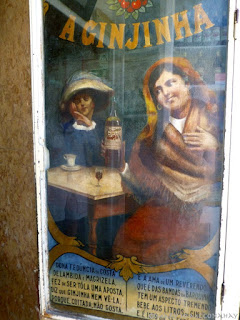 There are corners of Lisbon where you can breathe the air of
the time of Tango War, the years when turmoil around World War II cut through
Latin countries on both sides of the Atlantic. The café where poet Fernando
Pessoa wrote every day is still open just off one side of the Rossio Square,
and on the other side, tables are full at the Pasteleria Suicá where spies with
a variety of allegiances met over dark espressos and egg custard tarts.
There are corners of Lisbon where you can breathe the air of
the time of Tango War, the years when turmoil around World War II cut through
Latin countries on both sides of the Atlantic. The café where poet Fernando
Pessoa wrote every day is still open just off one side of the Rossio Square,
and on the other side, tables are full at the Pasteleria Suicá where spies with
a variety of allegiances met over dark espressos and egg custard tarts.  Jewelry
stores still offer gold, the bottom-line investment of those days, and pocket
shops dispense shots of cherry ginjinha
liquor.
Jewelry
stores still offer gold, the bottom-line investment of those days, and pocket
shops dispense shots of cherry ginjinha
liquor. 
Towering over the square stands a pedestal topped by the figure of
Peter IV, King of Portugal, who became Pedro I, Emperor of Brazil.
Linked to
Brazil especially by history, culture and language, and to Argentina and the
rest of the South American continent by the politics of Catholicism, in the
1930s and 1940s neutral Portugal served as safe haven and funnel for spies,
refugees and war criminals, many of whom found their way to the Americas.
Along with Nazi Germany and Fascist
Italy, Portuguese dictator António de Oliveira Salazar (Prime Minister
1933-1968) supported Franco and the Fascists in the Civil War in neighboring
Spain. He supplied precious resources, such as wolframite, to the Wehrmacht, and
saw the Reich as a bulwark against democracy and communism. Yet Salazar was not
racist – he wrote a book criticizing the 1935 Nuremburg Laws that codified Nazi
race theory and anti-Semitism. Salazar
reverted to a treaty with the English from the time of the Crusades to insist
that Portugal could not align itself with the Axis during the war.
 |
| Railroad Station |
Thus Lisbon, the elegant city on
the Tagus River Estuary that flows into the Atlantic, a city of trolleys
climbing its hills and exquisite tiles facing old buildings, became a haven for
the grateful escaping repression, and worse. And for the fortunate with money
from both sides, securing their wealth or risking it at card tables and
roulette wheels – stories abound of Reich officers gambling side by side with
Jewish businessmen and Middle Eastern oil potentates at the Casino above the
sands of Estoril beach at Lisbon’s edge. And, a haven for the nefarious,
plotting, plotting amid the blooming purple jacaranda trees.
 |
| Window today of Bertrand's, World's Oldest Bookstore (1732) |
Tango War, the book, is coming.















